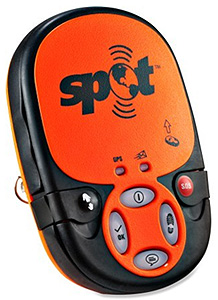I just activated the coolest Christmas gift ever… a SPOT Satellite GPS Messenger! Now when I go into the backcountry, my wife doesn’t have to worry about me getting stranded or lost without the ability to call for help.  This will also come in handy when we go out exploring where I can see two benefits:
This will also come in handy when we go out exploring where I can see two benefits:
1. Friends and family can follow our tracks online as we take part in outdoor adventures and,
2. We can request help either through a pre-configured help message to a friend list or dispatch an official SOS to 911 emergency services in the event something serious happens.
EMERGENCY COMMUNICATION
It wasn’t long ago that our only mechanism for such communication in remote mountain areas was done with an amateur radio (ham radio). Cell phone coverage is generally spotty and not something you would count on. Ham radio coverage is a little better. It just depends on how quickly someone would hear your distress calls over the air. With a SPOT messenger, you only need to press a button to dispatch whichever resources you decide are necessary for the situation at hand (friends or EMTs).
 REMOTE TRACKING
REMOTE TRACKING
As for seeing real-time tracks on a map, we were doing this with the Automatic Packet/Position Reporting System (APRS) from a GPS connected to a special ham radio. I had a Kenwood TH-D7 handheld with a Terminal Node Controller (TNC) that allowed 1200/9600bps packet communications. When connected to my Garmin eTrex GPS, this combination transmitted coordinates over digipeters that got picked up by APRS through IGates. I’ve done many-a-trip using this gear and related infrastructure, for both adventure-related activities and other. It’s been a fun setup to play with but the SPOT sure has made this a lot easier!
SPOT vs. APRS
Here’s my short list of pros and cons for each. The advantage with APRS is that the tracking “service” is free – data is just passed across the open airwaves. The downside is that it’s a little complicated with multiple components (ham radio, GPS, specialized cable), battery management of two devices, still subject to signal strength and coverage issues with local digipeters, as well as amateur radio operation requiring a license. The advantage with a SPOT is excellent coverage via satellite, immediate access to help at the push of a button, not to mention a compact, simple, single device that does not require a license nor any technical knowledge whatsoever. However, the downside is the annual subscription for real-time tracking, no two-way communication capability and an opportunity for abuse (don’t send out an SOS to deliver an ice pack for your twisted ankle because you’re 20 miles from the trailhead!).
![]()
I can wait to get out and start using my cool new SPOT satellite messenger!
